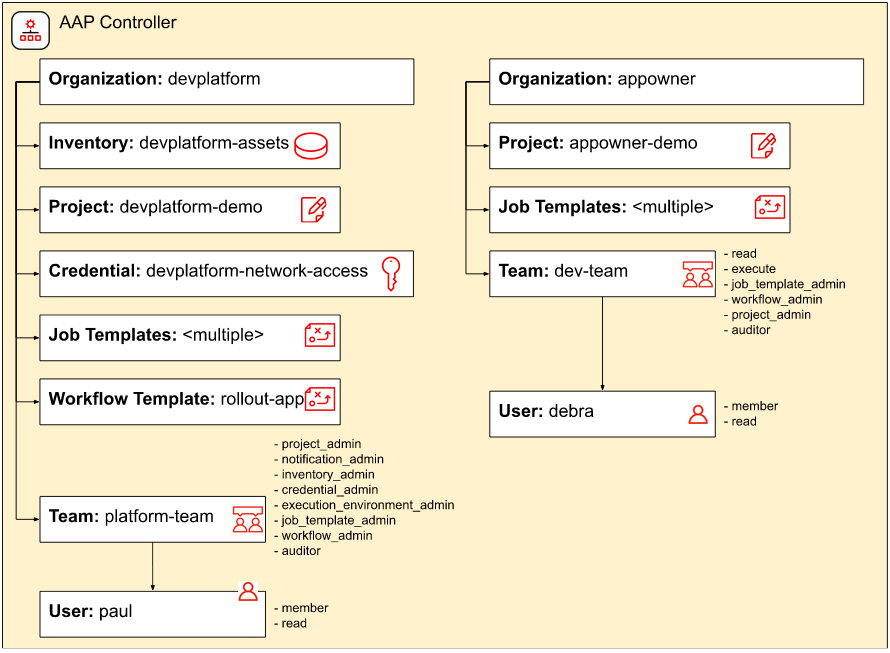Ansible for DevOps - Part 3
Deploy Automation Resources
Now that AAP and EDA are up and running, I start setting up the automation resources needed for the demo. This includes organizations, demo inventories, credentials and projects. The structure of what is created looks something like this:

The playbook also creates a series of job templates to simulate each of the stages of the application deployment, and an overall workflow to organise them. These stages are:
| Name | Organization | Task |
|---|---|---|
| 1-create | devplatform | Creates a ServiceNow Change Request |
| 2-prerollout | appowner | Perform any application-specific pre-rollout checks required. |
| S0-scheduled | devplatform | Update Change Request status to “scheduled” |
| S1-started | devplatform | Update Change Request status to “implement” |
| S2-failed | devplatform | Update Change Request status to “canceled” |
| S3-review | devplatform | Update Change Request status to “review” |
| S4-complete | devplatform | Update Change Request status to “closed” with closure code and notes |
| S5-failed | devplatform | Update Change Request status to “canceled” |
| 3-provision | devplatform | Provision the infrastructure required for the application installation |
| 4-postprovision | appowner | Perform application installation and configuration on known infrastructure |
| 5-tvt | appowner | Perform diagnostic tests on the application to ensure deployment has succeeded |
| I1-incident | devplatform | Raise an Incident in ServiceNow |
The final workflow, with branching logic, looks like this:

The workflow job template also supports a parameter to “simulate” a failure in the workflow - rollout_status which can have the following values:
- fail_tvt - cause the workflow to fail at the TVT stage
- fail_precheck - cause the workflow to fail at the Precheck stage
- Any other value - let the workflow succeed
When a workflow template stage fails, the workflow will generate an Incident in ServiceNow (see below).
GitOps and Webhooks
To enable a webhook on the workflow template, allowing it to be triggered by a GitHub push, I set the webhook_service param to “github” when creating the workflow job template:
- name: Create a workflow template
ansible.controller.workflow_job_template:
name: "rollout-app-impl"
description: "Sample App Deployment Workflow with ServiceNow integration and Multiple Teams"
organization: "{{ org_platform.name }}"
inventory: "{{ org_platform.name }}-assets"
webhook_service: "github"
...However, the returned data from this play doesn’t include the webhook endpoint and the webhook key needed to configure GitHub. It took me a while to find a way to retrieve this. The endpoint can be retrieved by doing a lookup on the ansible.controller.controller_api module for the newly created workflow job template.
The returned data includes the endpoint path in the related.webhook_receiver parameter, so the full URL can be constructed:
- name: Load the workflow template settings to get webhook details
ansible.builtin.set_fact:
workflow_template: "\{\{ lookup('ansible.controller.controller_api',
'workflow_job_templates',
query_params = { 'name' : 'rollout-app-impl' },
host = aap_host,
username = aap_username,
password = aap_password,
verify_ssl = False) }}"
- name: Set the webhook_receiver URL
ansible.builtin.set_fact:
webhook_receiver: "https://{{ aap_host }}{{ workflow_template.related.webhook_receiver }}"However, the webhook key isn’t directly returned. This is referenced in the API as a child object of the main workflow_job_template. It turns out you can query this using the ansible.controller.controller_api lookup, even though it looks a little dodgy!
- name: Try and get the webhook secret
ansible.builtin.set_fact:
key_deets: "\{\{ lookup('ansible.controller.controller_api',
'workflow_job_templates/{{ workflow_template.id }}/webhook_key',
host = aap_host,
username = aap_username,
password = aap_password,
verify_ssl = False) }}"
- name: Set the webkook key
ansible.builtin.set_fact:
webhook_key: "{{ key_deets.webhook_key }}"We now have the webhook endpoint and key ready to configure in GitHub. Currently this is done manually, but could also be automated.
In the next post we’ll set up some demo RBACs on our organisations.